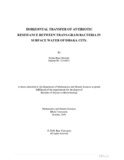Horizontal transfer of antibiotic resistance between trans-gram bacteria in surface water of Dhaka city

View/Open
Date
2019-10Publisher
Brac UniversityAuthor
Mostafa, Fariha BinteMetadata
Show full item recordAbstract
A global medical crisis has already started as antibiotics have started losing their effectiveness against the growing number of bacterial pathogens. Horizontal Gene Transfer (HGT) system has a great impact on this spreading of antibiotic resistance. However, the transformation dynamic is poorly understood. To find out the condition of surface water of Dhaka city that, how favorable it is for transformation of antibiotic resistance gene, Gulshan Lake and Hatirjheel Lake were chosen for this experiment, where natural transformation was performed between trans-gram bacteria Staphylococcus aureus and Salmonella typhi. From the 10 isolates, that were collected from BRAC university laboratory, 3 highest resistance showing isolates of Salmonella (Salmonella GL6.2, Salmonella HJ & Salmonella HJ3.1) were chosen as donor and one ATCC strain of Staphylococcus aureus was confirmed as recipient by the Kirby-Buer disk diffusion method. Finally, transformation was performed in Gulshan lake water and in hatirjheel lake water mixing the chromosomal DNA (Boiling method) and plasmid DNA (Kado-Liu method) of donor with recipient. Further, the confirmation test of transformation showed that, no DNA was uptake in any sample of the Gulshan and Hatirjheel lake water against any of the two specific antibiotics (Azithromycin & Tetracycline). The findings from this experiment indicates that, though horizontal gene transfer has a lot of impact in the spread of antibiotic resistance, spreading through natural transformation between gram positive and gram-negative organism might not be a very common phenomenon. At this time of rapid spreading of antibiotic resistance, this finding will help us to think in different ways of possible trans-gram transformations.
